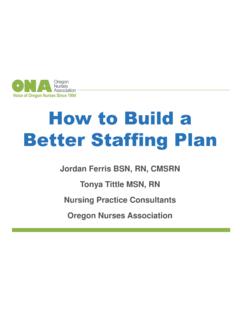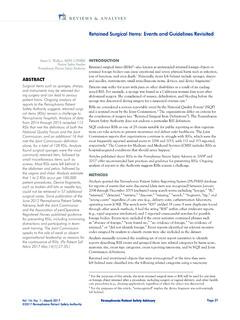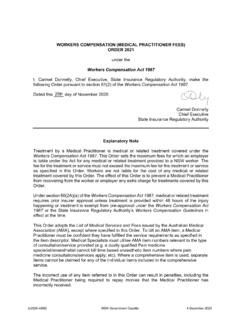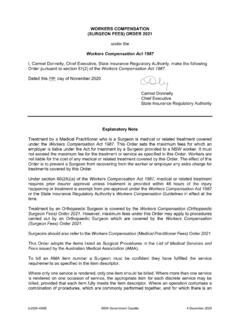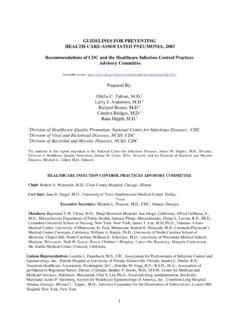Transcription of Introduction to Perioperative Nursing
1 Introduction to Perioperative NursingLearner Objectives1. Define the three phases of the surgical Describe the scope of Perioperative Nursing Identify members of the surgical Discuss application of the Perioperative Nursing Data Set (PNDS).5. Discuss the outcomes a patient can be expected to achieve following a surgical Describe the roles of surgical team Describe the responsibilities of the Perioperative nurse in the circulating OutLine I. Phases of the Surgical Experience A. Preoperative B. Intraoperative C. Postoperative II. Nursing Process Throughout the Perioperative Period A.
2 Assessment B. Nursing Diagnoses C. Planning D. Intervention E. Evaluation III. Perioperative Nursing Data Set IV. Patient Outcomes: Standards of Perioperative Care V. Roles of the Perioperative nurse VI. Expanded and Advanced Practice Roles VII. Practice Settings VIII. Members and Responsibilities of the Surgical TeamPhases of the surgical experience 1. The Perioperative period begins when the patient is informed of the need for surgery, includes the surgical procedure and recovery, and continues until the patient resumes his or her usual activities. The surgical experience can be segregated into three phases: (1) preopera-tive, (2) intraoperative, and (3) postoperative.
3 The word Perioperative is used to encom-pass all three phases. The Perioperative nurse provides Nursing care during all three phases. Preoperative 2. The preoperative phase begins when the patient, or someone acting on the patient s behalf, is informed of the need for surgery and makes the decision to have the procedure. This phase ends when the patient is transferred to the operating room The preoperative phase is the period that is used to physically and psychologically prepare CHAPTER11 Jones & Bartlett Learning, LLC. NOT FOR SALE OR DISTRIBUTIONthe patient for surgery.
4 The length of the pre-operative period varies. For the patient whose surgery is elective, the period may be lengthy. For the patient whose surgery is urgent, the period is brief; the patient may have no aware-ness of this Diagnostic studies and medical regimens are initiated in the preoperative period. Informa-tion obtained from preoperative assessment and interview is used to prepare a plan of care for the Nursing activities in the preoperative phase are directed toward patient support, teaching, and preparation for the 6. The intraoperative phase begins when the patient is transferred to the operating room bed and ends with transfer to the postanesthesia care unit (PACU) or another area where imme-diate postsurgical recovery care is During the intraoperative period, the patient is monitored, anesthetized, prepped, and draped, and the procedure is Nursing activities in the intraoperative period center on patient safety, facilitation of the pro-cedure, prevention of infection, and satisfac-tory physiologic response to anesthesia and surgical intervention.
5 Postoperative 9. The postoperative phase begins with the patient s transfer to the recovery unit and ends with the resolution of surgical sequelae. The postoperative period may be either brief or extensive, and most commonly ends outside the facility where the surgery was performed. 10. For patients who will remain in the hospital for an extended stay, the Perioperative nurse may not provide care beyond patient transfer to the PACU, where postanesthesia care nurses assume responsibility for the patient. In an effort to better utilize Nursing resources, many Perioperative nurses, particularly in smaller hospitals, have been trained in postanesthesia care and are assuming responsibility for pro-viding care in both the operating room and PACU.
6 Care at home, if required, is delivered by home healthcare The majority of operative procedures per-formed today are done on an outpatient basis. For patients who undergo surgery in ambula-tory surgery facilities, day surgery centers, or office-based surgical settings where the expec-tation is that they will return home on the same day they have surgery, it is not uncommon for the Perioperative nurse to provide care for the patient during all three Nursing activities in the immediate postopera-tive phase center on support of the patient s physiologic systems. In the later stages of recovery, much of the focus is on reinforcing the essential information that the patient and other caregivers require in preparation for discharge.
7 Nursing Process throughout the Perioperative Period 13. The words Perioperative and Perioperative Nursing are accepted and utilized in Nursing and medical literature. Perioperative Nursing was formerly referred to as operating room Nursing , a term that historically referred to patient care provided in the intraoperative period and administered within the operating room itself. However, as the responsibilities of the operating room nurse expanded to include care in the preoperative and postoperative periods, the term Perioperative was recog-nized as more appropriate.
8 In 1999, the orga-nization that represents Perioperative nurses, once known as the association of Operating Room Nurses (AORN), changed its name to the association of peri Operative registered Nurses (AORN).14. The Perioperative nurse is a nurse who special-izes in Perioperative practice and who provides Nursing care to the surgical patient throughout the continuum of care. The AORN Periop-erative Patient-Focused Model identifies four specific domains patient safety, physiologic response, behavioral responses, and the health system that are the areas of concern for the Perioperative nurse .
9 15. The domains of safety, physiologic response, and behavioral responses of patients reflect the nature of the surgical experience for the patient and serve as a guide for providing care. 16. The fourth domain represents other members of the healthcare team and the healthcare system. Perioperative nurses work collaboratively with other healthcare team members to formulate Nursing diagnoses, identify desired outcomes, 2 cHaPter 1 Introduction to Perioperative Nursing Jones & Bartlett Learning, LLC. NOT FOR SALE OR DISTRIBUTIONand provide care within the context of the healthcare system so as to achieve desirable patient outcomes (AORN, 2012a, pp.)
10 3 4).17. Perioperative nurses provide patient care within the framework of the Nursing process. They use the tools of patient assessment, care planning, intervention, and evaluation of patient outcomes to meet the needs of patients who are under-going operative or other invasive procedures. Every patient is unique, and the plan of care is tailored to meet the patient s specific needs. The plan addresses physiological, psychological, sociocultural, and spiritual aspects of care. 18. Much of Perioperative Nursing involves tech-nical expertise, including responsibility for equipment, instrumentation, and surgical tech-niques.










